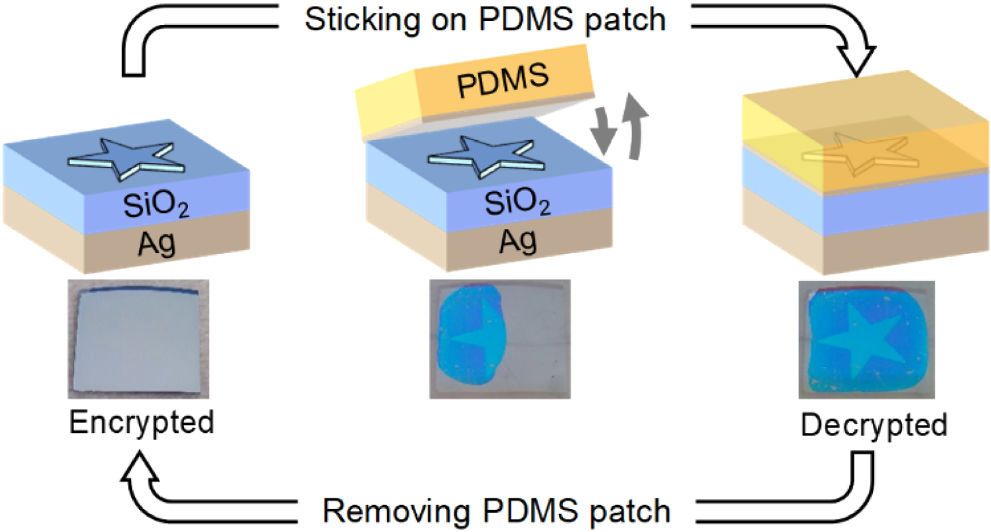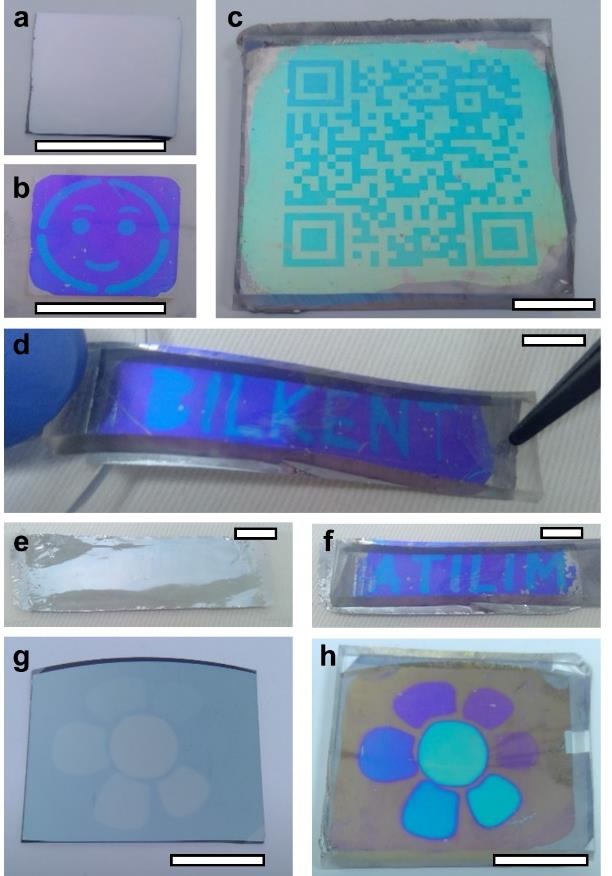About
12 September 2019
Researchers Use Metamaterials to Create Two-Part Optical Security Features
New encryption method could make it harder to counterfeit money or intercept secure information sent by mail
WASHINGTON —Researchers have developed advanced optical security features that use a two-piece metamaterial system to create a difficult-to-replicate optical phenomenon. Metamaterials are engineered to have a property that is not found in naturally occurring materials. The new security features could offer improved forgery protection for high-value products or banknotes and enhance encryption of information such as pin numbers that are physically sent to recipients.

Caption: Researchers developed a two-part security feature that allows dynamic and reversible decryption. The figure illustrates an encrypted star pattern generated by raising the dielectric SiO2 layer by 10 nm. The star pattern is revealed when a thin-metal-coated elastomeric (PDMS) patch is applied. The star is 1 cm wide.
Credit: Gokhan Bakan, University of Manchester
Optical security features are often used today to verify the authenticity of currency, identification cards and valuable products such as electronics. These features include holograms that change color at different viewing angles or patterns that appear only under ultraviolet light. Security features with many hard-to-replicate features are the most secure because they are difficult to reproduce.
“An ideal optical security feature must be hard to copy by unlicensed people, easy to produce in mass, and be interrogated conveniently,” said research team leader Gokhan Bakan from the University of Manchester in the UK. “Our approach satisfies all these requirements and could offer more secure goods and information transactions for everyone.”
In The Optical Society (OSA) journal Optics Letters, the researchers describe a system in which two thin optical pieces must be placed together to form a metamaterial that reveals a hidden message or QR code that is readable to the naked eye. Re-encryption is performed by peeling off the top part, which contains no information, from the bottom portion that encodes a message.
To protect sensitive information such as a credit card pin, a customer could get the top part of the security feature (the key) from the bank at the time of application. When the encrypted pin arrives by mail the customer would use the key to reveal the pin. If the printout with the encrypted pin number on it is stolen, it would be impossible to decrypt it without the key.
Revealing the secret message
The new two-part security features have a bottom portion that is formed by coating a thin insulating material, or dielectric, on a silver film that is about 120 nanometers thick. This bottom portion is essentially a mirror in that it reflects most of the incoming light. Because its optical properties are defined by the silver film and not affected by the dielectric layer’s thickness a message can be hidden on the dielectric by simply adding more dielectric in the shape of the message.

Caption: The researchers used their two-part approach to create optical security features to hide (a) and reveal (b) a variety of patterns including a QR code pattern (c). They also demonstrated the use of plastic (d) and (e-f) aluminum foil (e-f) as flexible substrates. Different colors can be generated (g-h) by changing the dielectric thickness. Scale bars are 1 cm.
Credit: Gokhan Bakan, University of Manchester
The top part of the security feature is a transparent elastic substrate coated with a metal layer that is about 10 nanometers thick. This part, which acts as a key, doesn’t hold any information and appears semi-transparent. When the two parts are put together, with the thin metal on the top part facing the bottom part, it forms an optical cavity whose properties, such as surface color, strongly depend on the dielectric thickness. Thus, as the two pieces are placed together, a stark color contrast appears and reveals the hidden message, which is readable to the naked eye. The approach can be used to create keys that are specific to each message or to make a master key that would work for any message.
“When the two parts of the security feature are stuck together, it creates an optical phenomenon known as the plasmonics-enhanced optical cavity effect,” said Bakan. “Although this effect is commonly employed for a variety of applications such as optical filters, we uniquely separated the optical cavity into two, allowing information to be hidden in one part in a way that can only be revealed with the right key.”
Flexible security
The researchers demonstrated their new approach by encoding QR codes on rigid substrates as well as flexible substrates that could be used on almost any surface, including banknotes. The QR codes were invisible to the naked eye until an adhesive patch made of the transparent elastic substrate was applied. They also used the approach to encode various patterns and words.
Although the researchers demonstrated an application specific to optical security, the approach could also be used for optical sensing for chemical or biological applications. For example, if certain proteins attached to a thin-film, the modular metamaterial could produce a read-out that was visible to the naked-eye or readable to a camera.
The researchers plan to further develop the new optical security feature by using it with other optical phenomena. They also want to communicate the technology with developers of security tags and banks so that the technology could be tested and developed for real-world applications.
“Our research shows that converting static optical features to modular ones can open up completely new applications,” said Bakan. “This offers a new perspective that scientists could use to expand other established optical methods.”
Paper: G. Bakan, S. Ayas, M. Serhatlioglu, A. Dana, C. Elbuken, “Reversible decryption of covert nanometer-thick patterns in modular metamaterials,” Opt. Lett., 44, 18, 4507-4510 (2019).
DOI: https://doi.org/10.1364/OL.44.004507
About The Optical Society
The Optical Society (OSA) is dedicated to promoting the generation, application, archiving, and dissemination of knowledge in optics and photonics worldwide. Founded in 1916, it is the leading organization for scientists, engineers, business professionals, students, and others interested in the science of light. OSA’s renowned publications, meetings, online resources, and in-person activities fuel discoveries, shape real-life applications and accelerate scientific, technical, and educational achievement.
About Optics Letters
Optics Letters has been publishing high-impact research in the field of photonics for over 45 years and offers rapid dissemination of new results in all areas of optical science with short, original, peer-reviewed communications. Optics Letters accepts papers that are noteworthy to a substantial part of the optics community. Published by Optica Publishing Group and led by Editor-in-Chief Miguel Alonso, Institut Fresnel, École Centrale de Marseille and Aix-Marseille Université, France, University of Rochester, USA. For more information, visit Optics Letters.
Media Contact
